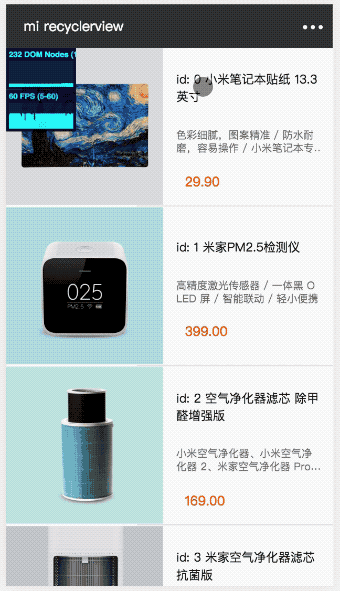qtt-recyclerview
v0.4.1
Published
[](https://www.npmjs.com/package/vue-recyclerview)
Downloads
8
Maintainers
Readme
vue-recyclerview
Mastering Large Lists with the vue-recyclerview
Feature
- DOM recyleing
- Multiple column
- Waterflow
Preview

Demo
https://hilongjw.github.io/vue-recyclerview/
Requirements
Vue 2.0 +
Installation
Direct Download / CDN
https://unpkg.com/vue-recyclerview/dist/vue-recyclerview
unpkg.com provides NPM-based CDN links. The above link will always point to the latest release on NPM. You can also use a specific version/tag via URLs like https://unpkg.com/vue-recyclerview/dist/vue-recyclerview.js
Include vue-recyclerview after Vue and it will install itself automatically:
<script src="https://unpkg.com/vue/dist/vue.js"></script>
<script src="https://unpkg.com/vue-recyclerview/dist/vue-recyclerview.js"></script>NPM
$ npm install vue-recyclerviewWhen used with a module system, you must explicitly install the vue-recyclerview via Vue.use():
import Vue from 'vue'
import VueRecyclerviewNew from 'vue-recyclerview'
Vue.use(VueRecyclerviewNew)You don't need to do this when using global script tags.
Dev Build
You will have to clone directly from GitHub and build vue-recyclerview yourself if
you want to use the latest dev build.
$ git clone [email protected]:hilongjw/vue-recyclerview.git node_modules/vue-recyclerview
$ cd node_modules/vue-recyclerview
$ npm install
$ npm run buildGetting Started
We will be using ES2015 in the code samples in the guide.
main.js
// If using a module system (e.g. via vue-cli), import Vue and RecyclerView and then call Vue.use(RecyclerView).
// import Vue from 'vue'
// import RecyclerView from 'vue-recyclerview'
// import App from './App.vue'
// Vue.use(RecyclerView)
// Now the app has started!
new Vue({
render: h => h(App)
}).$mount('#app')App.vue
<template>
<div id="app">
<RecyclerView
:prerender="30"
style="height: calc(100vh - 50px)"
:fetch="MiFetch"
:item="MiItem"
:tombstone="MiTomstone"
></RecyclerView>
</div>
</template>
<script>
import MiItem from './MiItem.vue'
import MiTomstone from './MiTombstone.vue'
import MiFetch from './mi-fetch'
export default {
name: 'app',
data () {
return {
MiFetch,
MiItem,
MiTomstone
}
}
}
</script>Props Options
|key|description|defualt|type/options|
|:---|---|---|---|
| fetch|Data fetching function |||
|list|List data of RecyclerView|[]|
|prerender|Number of items to instantiate beyond current view in the opposite direction.|20|Number|
|remain|Number of items to instantiate beyond current view in the opposite direction.|10|Number|
|column|Specifies how many columns the listings should be displayed in|1|Number|
|item|The Vue component of RecyclerView's item||Vue component|
|tombstone|The Vue component of RecyclerView's tombstone||Vue component|
|loading|The loading component behind the RecyclerView pull-to-refresh |built-in loading|Vue component|
- fetch:Function
function fetch (limit:Number, skip:Number) {
return Promise.resolve({
list: list // Array,
count: count // Number
})
}
- list
[
// item
{
vm: vm, // <Vue Instance>
data: {
name: 'test'
},
node: null,
height: 100,
width: 100,
top: 0,
},
// tombstone
{
vm: null
data: null,
node: null,
height: 100,
width: 100,
top: 0,
}]Instance Method
- scrollToIndex
this.$refs.RecyclerView.scrollToIndex(100)
License
the project inspired by infinite-scroller

